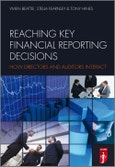Reaching Key Financial Reporting Decisions: How Directors and Auditors Interact is a fascinating, behind-the-scenes examination of this closed process. The authors draw on the results of face to face interviews, and an extensive survey of finance directors, audit committee chairs and audit partners, and present nine company case studies highlighting the process of discussion and negotiation and the methods by which the agreed financial reporting outcome was reached. Detailed analysis of the case studies:
- Allows those involved in the process to benchmark their behaviours against those of others
- Enables a comparison between the previous and current regulatory environments to see what has changed, and sheds light on the sorts of behaviours the current regulatory framework encourages
- Evaluates the effectiveness of the changed regulatory regime, providing evidence relevant to current policy debates concerning the value of audit, IFRS and the relative merit of rules-based versus principles-based accounting standards in relation to professional judgement and compliance
The unprecedented access and unique insights offered by this book make it invaluable for audit firm staff and partners, audit committee chairs and company directors involved in agreeing the published financial statements, as well as those who have an interest in the financial statements, but do not have access to the negotiation process.
Table of Contents
List of Figures.List of Tables.
Foreword (Peter Wyman).
Preface.
Acknowledgements.
Abbreviations.
PART I THE BACKGROUND.
1 Introduction and Background.
1.1 What This Book is About.
1.2 Recent Regulatory Changes.
1.3 Contribution of This Book in the 2010/2011 Regulatory Environment.
1.4 Research Approach.
1.5 Outline of Book.
1.6 Key Findings and Conclusions.
2 Review of Relevant Literature.
2.1 Overview.
2.2 Regulation.
2.3 IFRS.
2.4 Audit Quality.
2.5 Enforcement.
2.6 Corporate Governance and the Role of the Audit Committee.
2.7 Interactions and Negotiation in Non-Audit Settings.
2.8 Interactions and Negotiation in Audit Settings.
3 The Survey.
3.1 Overview.
3.2 Methods.
3.3 Findings.
3.4 Interaction Issues.
3.5 Financial Statement Changes.
3.6 Summary.
PART II THE CASE STUDIES.
4 Case Studies.
4.1 Introduction to the Case Studies.
4.2 How the Case Companies were Selected and Approached.
4.3 Broad Approach to the Grounded Theory Analysis.
4.4 Writing Up Each Case (Matched Set of Interviews) -The Stories.
4.5 Preliminary Within-Case Analysis: Attaching Labels to the Key Categories.
4.6 Within-case Analysis.
4.7 Tabular Summary of Cases.
5 Case 1-Sandpiper plc.
5.1 Background to the Case.
5.2 Corporate Governance.
5.3 Key Interactions Between Stuart, Duncan and Patrick.
5.4 Contextual Factors and Analysis of the Interactions.
5.5 Conclusions.
6 Case 2-Kestrel plc.
6.1 Background to the Case.
6.2 Corporate Governance.
6.3 Key Interactions Between Philip, Guy and Barry.
6.4 Contextual Factors and Analysis of the Interactions.
6.5 Conclusions.
7 Case 3-Mallard plc.
7.1 Background to the Case.
7.2 Corporate Governance.
7.3 Key Interactions Between Jack, Paul and Gerald.
7.4 Contextual Factors and Analysis of the Interactions.
7.5 Conclusions.
8 Case 4-Finch plc.
8.1 Background to the Case.
8.2 Corporate Governance.
8.3 Key Interactions Between Ben, Robert and Damien.
8.4 Contextual Factors and Analysis of the Interactions.
8.5 Conclusions.
9 Case 5-Cormorant plc.
9.1 Background to the Case.
9.2 Corporate Governance.
9.3 Key Interactions Between William, Dave and Simon.
9.4 Contextual Factors and Analysis of the Interactions.
9.5 Conclusions.
10 Case 6-Pochard plc.
10.1 Background to the Case.
10.2 Corporate Governance.
10.3 Key Interactions Between Peter, Alan and Henry.
10.4 Contextual Factors and Analysis of the Interactions.
10.5 Conclusions.
11 Case 7-Woodpecker plc.
11.1 Background to the Case.
11.2 Corporate Governance.
11.3 Key Interactions Between Richard, Horace and Edward.
11.4 Contextual Factors and Analysis of the Interactions.
11.5 Conclusions.
12 Case 8-Raven plc.
12.1 Background to the Case.
12.2 Corporate Governance.
12.3 Key Interactions Between Trevor, Norman and Ivan.
12.4 Contextual Factors and Analysis of the Interactions.
12.5 Conclusions.
13 Case 9-Ostrich plc.
13.1 Background to the Case.
13.2 Corporate Governance.
13.3 Key Interactions Between Matthew, Victor and Luke.
13.4 Contextual Factors and Analysis of the Interactions.
13.5 Conclusions.
PART III CROSS-CASE ANALYSIS AND CONCLUSIONS.
14 Views of Interviewees on the Regulatory Framework.
14.1 Introduction.
14.2 Financial Reporting Issues.
14.3 Auditing Issues.
14.4 Corporate Governance.
14.5 Summary.
15 Attributes and Procedures of the Audit Committee and the Audit Committee Chair: Evidence.
15.1 Overview.
15.2 The Audit Committee.
15.3 The Role of the Audit Committee Chair.
15.4 Issues Discussed at Audit Committee Meetings.
15.5 Conclusions and Contribution to the Academic Literature.
16 Cross-case Analysis and Theory Development.
16.1 Introduction.
16.2 Summary of Interaction Attributes.
16.3 Summary of Cross-case Analysis.
16.4 A Revised Grounded Theory of Financial Reporting Interactions -Overview.
16.5 General Company/Audit Firm Context.
16.6 Specific Context.
16.7 International Regulatory Regime.
16.8 National Regulatory Regime.
16.9 Interactions (Core Category).
16.10 Outcome Determinants.
16.11 Comparison with Extant Literature.
17 Conclusions.
17.1 Overview.
17.2 The Regulatory Setting.
17.3 Evidential Base and Structure of Findings.
17.4 The Nature of Financial Reporting Interactions Between FDs, ACCs and AEPs.
17.5 The Interaction Process.
17.6 Interaction Outcomes.
17.7 The Regulatory Framework.
17.8 The ACC and the Audit Committee.
17.9 Policy Implications.
17.10 Limitations and Implications for Future Research and Regulatory Interest.
References.
Index.








